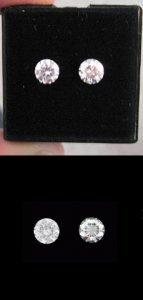You are using an out of date browser. It may not display this or other websites correctly.
You should upgrade or use an alternative browser.
You should upgrade or use an alternative browser.
Testing light return without an idealscope?
- Thread starter vsp08
- Start date
- Joined
- May 1, 2008
- Messages
- 3,563
You may not be able to check it robustly with a scope, though it's possible to a degree. You can place it next to a known performer and make comparisons through a range of lighting conditions.
Example: The CZ set below has one well-cut round (6mm) next to a round with leakage (6.25mm).
Under bright lights they appear equivalent. In fact, under spotlighting, the one on the right seems a bit bigger (because it is). But as soon as they're under normal or soft lighting the bigger one goes dark at the edges - loses life at its center - and now looks smaller than the other.
I nearly always have this display set with me - credit to Garry Holloway for that. When people ask about the importance of cut I show it under bright lights and ask "Do these appear about the same size?" Yes. Then I tell the person to cup a hand over them and look again. The next comment is always "Oh wow!"

Leakage is best seen in conditions where there is little overhead light, or the light that's dim/diffused. Leakage gets disguised when the diamond is under multiple spotlights and bright overhead lighting.vsp08|1392160679|3613138 said:Or rather, in what lighting would light leakage be the most obvious?
Example: The CZ set below has one well-cut round (6mm) next to a round with leakage (6.25mm).
Under bright lights they appear equivalent. In fact, under spotlighting, the one on the right seems a bit bigger (because it is). But as soon as they're under normal or soft lighting the bigger one goes dark at the edges - loses life at its center - and now looks smaller than the other.
I nearly always have this display set with me - credit to Garry Holloway for that. When people ask about the importance of cut I show it under bright lights and ask "Do these appear about the same size?" Yes. Then I tell the person to cup a hand over them and look again. The next comment is always "Oh wow!"

Thanks John! Your response is super helpful.
I'm just curious because I purchased my diamond before fully discovering PS (I used the HCA tool though), and have never looked at it through an idealscope. I am very happy with its performance but have wondered about light leakage. It appears white and bright on cloudy days and when the light is being blocked by something (i.e. when I hold my hand under a table). Obviously there isn't much I could do about it now anyway, but reading PS makes you wonder about these things! Lol
I'm just curious because I purchased my diamond before fully discovering PS (I used the HCA tool though), and have never looked at it through an idealscope. I am very happy with its performance but have wondered about light leakage. It appears white and bright on cloudy days and when the light is being blocked by something (i.e. when I hold my hand under a table). Obviously there isn't much I could do about it now anyway, but reading PS makes you wonder about these things! Lol
c-k
Shiny_Rock
- Joined
- May 8, 2013
- Messages
- 339
John Pollard|1392163486|3613170 said:You may not be able to check it robustly with a scope, though it's possible to a degree. You can place it next to a known performer and make comparisons through a range of lighting conditions.
Leakage is best seen in conditions where there is little overhead light, or the light that's dim/diffused. Leakage gets disguised when the diamond is under multiple spotlights and bright overhead lighting.vsp08|1392160679|3613138 said:Or rather, in what lighting would light leakage be the most obvious?
Example: The CZ set below has one well-cut round (6mm) next to a round with leakage (6.25mm).
Under bright lights they appear equivalent. In fact, under spotlighting, the one on the right seems a bit bigger (because it is). But as soon as they're under normal or soft lighting the bigger one goes dark at the edges - loses life at its center - and now looks smaller than the other.
I nearly always have this display set with me - credit to Garry Holloway for that. When people ask about the importance of cut I show it under bright lights and ask "Do these appear about the same size?" Yes. Then I tell the person to cup a hand over them and look again. The next comment is always "Oh wow!"
John, thanks for such a great example, I also say Wow, really tells the story.
Share:
How Are Diamonds Made? Natural vs Lab-Created Explained How Are Diamonds Made? Natural vs Lab-Created Explained - 08/05
How Are Diamonds Made? Natural vs Lab-Created Explained - 08/05

Top Wedding Ring Brands for Every Style and Budget
Top Wedding Ring Brands for Every Style and Budget - 08/05
Where to Buy Lab Grown Diamonds: Best Places Compared
Where to Buy Lab Grown Diamonds: Best Places Compared - 08/05






300x240.png)